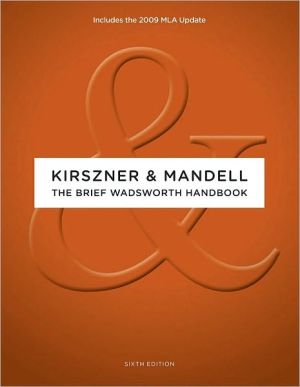The Brief Wadsworth Handbook, 2009 MLA Update Edition
The most comprehensive brief handbook available, THE BRIEF WADSWORTH HANDBOOK, SIXTH EDITION, provides students with extensive coverage of rhetorical concerns, the writing and research process, writing and researching with computers, visual rhetoric, and other topics essential for 21st-century student writers. This versatile and proven text is a uniquely effective guide to help students develop the critical thinking, reading, and writing skills they need to become successful communicators in...
Search in google:
The most comprehensive brief handbook available, THE BRIEF WADSWORTH HANDBOOK, SIXTH EDITION, provides students with extensive coverage of rhetorical concerns, the writing and research process, writing and researching with computers, visual rhetoric, and other topics essential for 21st-century student writers. This versatile and proven text is a uniquely effective guide to help students develop the critical thinking, reading, and writing skills they need to become successful communicators in college and beyond. Practicing teachers and collaborative writing partners throughout their careers, Kirszner and Mandell bring an in-the-trenches" pragmatic understanding of instructor and student needs to every page of this Sixth Edition. This edition has been updated to reflect guidelines from the 2009 MLA HANDBOOK FOR WRITERS OF RESEARCH PAPERS, SEVENTH EDITION."
Part I: WRITING ESSAYS. 1. Understanding Purpose and Audience. 2. Reading Texts. 3. Reading Visuals. 4. Planning an Essay. 5. Using a Thesis to Shape Your Material. 6. Drafting and Revising. 7. Writing Paragraphs. Part II: CRITICAL THINKING AND ARGUMENTATION. 8. Thinking Critically. 9. Writing Argumentative Essays. 10. Using Visuals as Evidence. Part III: WRITING IN THE DISCIPLINES. 11. Writing in the Humanities. 12. Writing a Literary Analysis. 13. Writing in the Social Sciences. 14. Writing in the Natural and Applied Sciences. Part IV: DOING RESEARCH. 15. Writing a Research Paper. 16. Using and Evaluating Library Sources. 17. Using and Evaluating Web Sources. 18. Summarizing, Paraphrasing, and Quoting Sources. 19. Synthesizing Sources. 20. Avoiding Plagiarism. Part V: DOCUMENTING SOURCES: MLA STYLE. 21. MLA Documentation Style. Part VI: DOCUMENTING SOURCES: APA AND OTHER STYLES. 22. APA Documentation Style. 23. Chicago Documentation Style. 24. CSE Documentation Style. Part VII: CREATING DOCUMENTS IN A DIGITAL AGE. 25. Writing in a Digital Environment. 26. Designing Effective Documents. 27. Creating a Web Site. Part VIII: STRATEGIES FOR SUCCESS IN COLLEGE AND BEYOND. 28. Creating a Writing Portfolio. 29. Writing Essay Exams. 30. Writing for the Public. 31. Writing for the Workplace. 32. Making Oral Presentations. Part IX: REVISING COMMON SENTENCE ERRORS. 33. Revising Sentence Fragments. 34. Revising Run-Ons. 35. Revising Agreement Errors. 36. Revising Awkward or Confusing Sentences. 37. Revising Misplaced and Dangling Modifiers. Part X: WRITING GRAMMATICAL SENTENCES. 38. Using Verbs. 39. Using Nouns and Pronouns. 40. Using Adjectives and Adverbs. Part XI: IMPROVING SENTENCE STYLE. 41. Writing Varied Sentences. 42. Writing Emphatic Sentences. 43. Writing Concise Sentences. 44. Using Parallelism. 45. Choosing Words. Part XII: UNDERSTANDING PUNCTUATION. 46. Using End Punctuation. 47. Using Commas. 48. Using Semicolons. 49. Using Apostrophes. 50. Using Quotation Marks. 51. Using Other Punctuation Marks. Part XIII: UNDERSTANDING SPELLING AND MECHANICS. 52. Improving Spelling. 53. Knowing When to Capitalize. 54. Using Italics. 55. Using Hyphens. 56. Using Abbreviations. 57. Using Numbers. Part XIIII: RESOURCES FOR BILINGUAL AND ESL WRITERS. 58. Grammar and Style for ESL Writers. Appendix A: Parts of Speech. Appendix B: Sentence Review. Appendix C: Glossary of Usage. Credits. Index.








